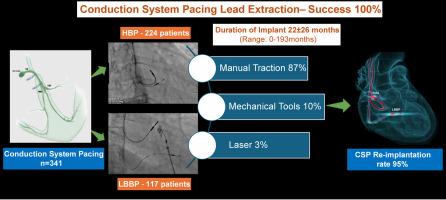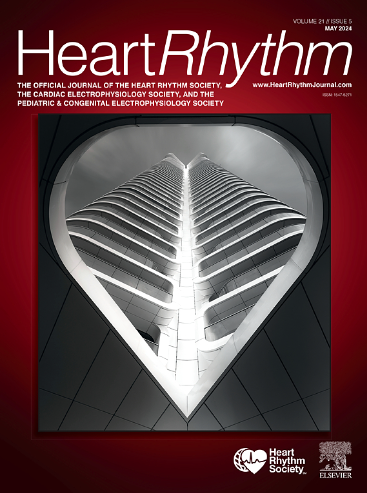Transvenous extraction of conduction system pacing leads: An international multicenter (TECSPAM) study
IF 5.7
2区 医学
Q1 CARDIAC & CARDIOVASCULAR SYSTEMS
引用次数: 0
Abstract
Background
Conduction system pacing (CSP) by His bundle pacing or left bundle branch area pacing (LBBAP) is incorporated into Heart Rhythm Society guidelines for the management of bradycardia and cardiac resynchronization therapy. Despite increasing adoption with both lumenless leads and stylet-driven leads, concerns regarding the feasibility and safety of the extraction of CSP leads remain.
Objective
The aim of the study was to report on the safety, feasibility, and clinical outcomes of the extraction of CSP leads.
Methods
Patients undergoing the extraction of CSP leads from 10 international centers were enrolled in this retrospective study. Data regarding indications, lead location, lead type, extraction tools, procedural success, complications, and reimplantation in the conduction system were collected.
Results
Overall, 341 patients (age 69 ± 15 years; female 117 (34%); cardiomyopathy 157 (46%); lead dwell time 22 ± 26 months) underwent the extraction of 224 His bundle pacing and 117 LBBAP leads (lumenless leads 321; stylet-driven leads 20). Complete procedural success was achieved in 338 (99%), while clinical success was 100% with retained distal fragments in 3 patients (1%). Among patients with a lead dwell time of >6 months (6–193 months; n = 226), manual extraction was successful in 198 (87%), mechanical tools in 22 (10%), and laser in 6 (3%). Femoral tools were necessary in 3 patients. Minor complications occurred in 7 patients (2.1%). Reimplantation in the conduction system was successful in 233 of 244 patients attempted (95%).
Conclusion
The overall success rates of the extraction of CSP leads were very high (although the LBBAP lead dwell time was <3 years), with a low need for extraction tools and minimal complication. Reimplantation in the conduction system is feasible and safe.

经静脉提取传导系统起搏导线:国际多中心(TECSPAM)研究。
背景:通过 His 束起搏或左束支区起搏(LBBAP)进行的传导系统起搏(CSP)已被纳入心脏节律学会用于治疗心动过缓和心脏再同步化治疗的指南。尽管无腔导联和支架驱动导联被越来越多地采用,但提取 CSP 导联的可行性和安全性仍令人担忧:该研究旨在报告抽取 CSP 导联的安全性、可行性和临床结果:这项回顾性研究招募了来自 10 个国际中心的接受 CSP 导联取出术的患者。收集了有关适应症、导联位置、导联类型、抽取工具、手术成功率、并发症和重新植入传导系统的数据:总共有 341 名患者(年龄 69 ± 15 岁;女性 117 人(34%);心肌病 157 人(46%);导联停留时间 22 ± 26 个月)接受了 224 个 His 束起搏导联和 117 个 LBBAP 导联(无腔导联 321 个;支架驱动导联 20 个)的抽取手术。手术完全成功的患者有 338 例(99%),临床成功率为 100%,但有 3 例患者(1%)的导联远端碎片残留。在导联停留时间超过 6 个月(6-193 个月;n = 226)的患者中,198 例(87%)人工拔管成功,22 例(10%)使用机械工具,6 例(3%)使用激光。有 3 名患者需要使用股骨工具。7名患者(2.1%)出现了轻微并发症。在 244 例患者中,有 233 例(95%)成功重新植入了传导系统:提取 CSP 导联的总体成功率非常高(尽管 LBBAP 导联的停留时间是
本文章由计算机程序翻译,如有差异,请以英文原文为准。
求助全文
约1分钟内获得全文
求助全文
来源期刊

Heart rhythm
医学-心血管系统
CiteScore
10.50
自引率
5.50%
发文量
1465
审稿时长
24 days
期刊介绍:
HeartRhythm, the official Journal of the Heart Rhythm Society and the Cardiac Electrophysiology Society, is a unique journal for fundamental discovery and clinical applicability.
HeartRhythm integrates the entire cardiac electrophysiology (EP) community from basic and clinical academic researchers, private practitioners, engineers, allied professionals, industry, and trainees, all of whom are vital and interdependent members of our EP community.
The Heart Rhythm Society is the international leader in science, education, and advocacy for cardiac arrhythmia professionals and patients, and the primary information resource on heart rhythm disorders. Its mission is to improve the care of patients by promoting research, education, and optimal health care policies and standards.
 求助内容:
求助内容: 应助结果提醒方式:
应助结果提醒方式:


